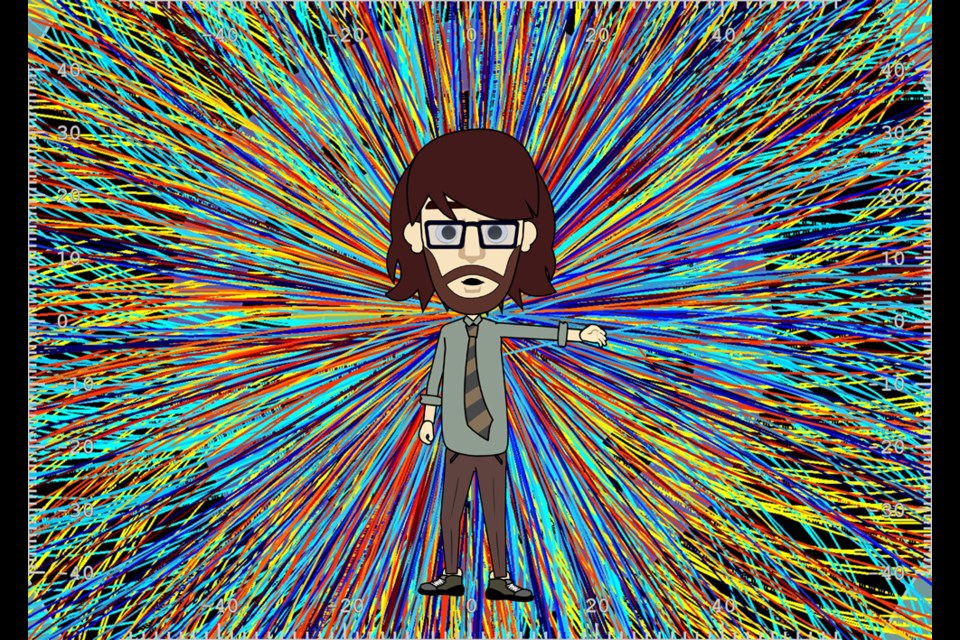The New Westminster New Media Gallery’s next exhibition is exploring the impact of animated cartoons.
Cartooney opens at the gallery on Friday, Oct. 18 and runs until Dec. 8, then again from Jan. 7 to Feb. 2.
Artist Kevin McCoy, one-half of the duo of Jennifer and Kevin McCoy, will be on hand for an artist talk on opening night, Friday, Oct. 18. The talk will run from 6:30 to 7:30 p.m., with a reception and open exhibition from 7:30 to 9 p.m.
Cartooney features six works by international artists, all of which deconstruct existing cartoons – from Looney Tunes to The Simpsons to Charlie Brown.
“The artists in this exhibition reframe our world,” says a press release about the show. “Here we are asked to consider the laws, systems and iconographies of the cartoon world while drawing parallels with our human world; physical laws, the laws of gravitation, matter and light, the physics of motion, and societal psychologies and behaviours.”
The release notes the show presents “fascinating catalogues and overlaying systems of symbolic language.”
“The purposeful demolition of expectation in these works mirrors the instabilities and dreams of modern life. They remind us that the pervasive medium of the cartoon can reflect and influence how we navigate the world,” it says.
The gallery is on the third floor at the Anvil Centre, 777 Columbia St. See www.newmediagallery.ca for more details.
WORKS IN THE SHOW
American Desert (for Chuck Jones), by Mungo Thomson (U.S.A.):
Thomson’s audiovisual wall projection is based on the famous series of Road Runner and Wile E. Coyote cartoons first broadcast in the 1950s and 1960s. Thomson strips the cartoon bare of all characters, their sound and action, leaving only the backgrounds depicting the great, empty landscapes of the American West: a disputed symbol of freedom, criss-crossed with roads and signs of human intervention.
The work emphasizes “the role of the desert in the cultural imagination as a sort of pure and indomitable wasteland beyond civilization.”
Every Anvil, by Jennifer + Kevin McCoy (U.S.A.):
The work includes a DVD audiovisual set and a video player in a wall-mounted suitcase, and the visitor is free to choose and play any of a series of discs. The artists have isolated hundreds of themed moments from the Looney Tunes cartoon series. “Together the comedic pratfalls coalesce to reveal a forensic examination of our fascination with compulsive violence that is revealing, potent and thought-provoking,” the release says.
Black Holes, by Martin Arnold (Austria):
This single-channel, looping audiovisual installation explores what Arnold calls the “psychoanalytic underbelly” of family entertainment. Black Holes deconstructs a few frames from a 1944 cartoon entitled How to Play Golf, featuring Goofy – in which Goofy pulls out a revolver and shoots himself in the head after failing to sink a hole. Arnold deconstructs the frames into what’s described as a “condensed, back-and-forth, juddering replay,” forcing us to focus on the moment.
Arnold, who originally trained in psychology, is a central figure in the Austrian avant-garde film movement.
Laws of Motion in a Cartoon Landscape, by Andy Holden (U.K.):
In his two-channel audiovisual installation, 57 minutes long, Holden becomes a cartoon avatar, giving both a lecture on cartoons and a cartoon lecture, describing how our world is best now understood as a cartoon. The project incorporates Greek philosophy, Stephen Hawking, critical theory, physics, art, the financial crisis and Donald Trump, while adapting 10 laws of cartoon physics to create a theory of the world and a prophetic glimpse of the world we live in.
All The Ways (The Simpsons), by Jason Salavon (U.S.A.):
This 23-minute audiovisual installation fuses every episode from 26 seasons of The Simpsons into an algorithmically mixed audiovidual collage and a large-scale colour mural that presents colour information for every episode from those 26 seasons, in a radiating concentric rectangle, arranged in sequence by season. It comprises 574 episodes and some 17.7 million frames.
“Not unlike an impressionist canvas, the piece continuously negotiates the space between representation and abstraction,” says the release.
CB-MMXVIII (I’ve been thinking of giving sleeping lessons), by Patten (U.K.):
In this multi-screen audiovisual installation, the artist duo Patten subjects Charlie Brown to all the digital stresses, distortions and manipulations available in 2018, testing his plasticity.
“Sampled texts from philosophy, science and critical theory criss-cross the screens and are linked with scrolling images related to the natural world, DNA, systems, multiples; all serving to influence our reading of the cartoon character and the texts,” says the release. The ambient soundtrack is a dramatically slowed down Linus and Lucy theme.



